Results from the June 2016 Scottish Agriculture Census
Statistics regarding the area of crops and other farmland, livestock, agriculture workforce and rented farmland, for Scotland in 2016.
This document is part of a collection
3. Commentary
3.1 Agricultural Area
Chart 1: Agricultural land use, June 2016
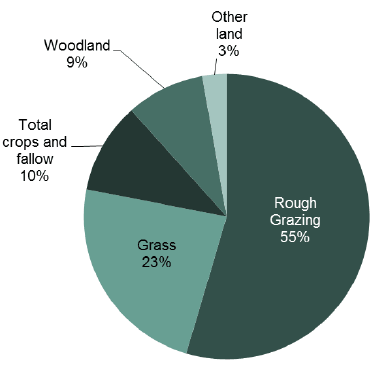
The total area on agricultural holdings at June 2016 was 5.65 million hectares, with the majority of this area being rough grazing (55 per cent). Almost a quarter (23 per cent) was grass, with 10 per cent used for crops or left fallow. The remainder consisted of woodland (nine per cent) and 'other land' (three per cent) comprised of roads, yards, buildings, scree, ponds and other such non-cultivated land.
There were 51,896 agricultural holdings, with the total area equating to 73 per cent of Scotland's total land area.
There was also a further 584,225 hectares of common grazing not included in these census results. If common grazing is included, the total area was 6.24 million hectares, which equates to 80 per cent of Scotland's total land area.
Chart 2: Agricultural land use trends, 2006 to 2016
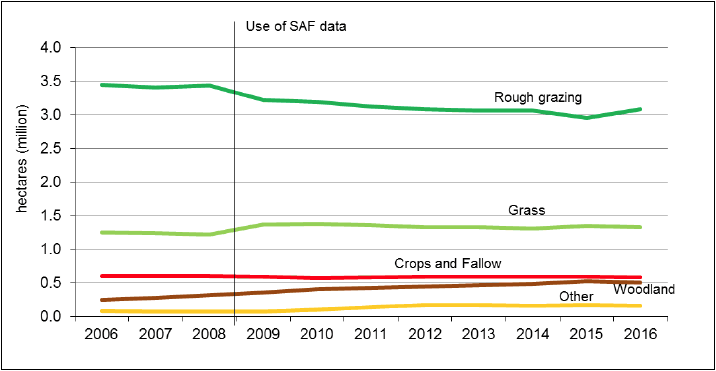
Over the past ten years, the total area on agricultural holdings has varied between 5.58 and 5.65 million hectares. This variation is likely to reflect changes to the coverage of agricultural holdings included in the June Census register, as well as genuine changes in total agricultural land.
For the first time since 2008 there was an increase in the area of rough grazing, rising 135,000 hectares (4.6 per cent). This change, however, may in part be due to changes in the Single Application Form [2] (SAF) rather than representing a genuine increase. It is no, for instance, that this rise has occurred in tandem with a drop in the area of woodland (by 22,000 hectares or 4.1 per cent), the first since 2005.
However, the general trend in relation to the area of woodland reported on agricultural holdings, shows that it has more than doubled over the past ten years. This may be partly due to increased coverage of this type of land by the June Census register, particularly in the years immediately following the use of SAF data from 2009, but consistent increases in woodland over the last decade suggest genuine increase is also driving the trend.
Overall, the area of grass fell (by 13,000 hectares or 1.2 per cent). In 2015, a change in how temporary grass was defined was accompanied by a shift from grass under five years old to grass five years and over. This year, the ratio of permanent grass to temporary grass has been largely maintained, with both categories falling broadly in proportion (temporary grass down 1.4 per cent and permanent grass down 0.9 per cent).
3.2 Crops, fallow and set-aside land
In 2016, there were 582,000 hectares of crops and fallow land, with cereals accounting for the majority (74 per cent or 432,000 hectares). Oilseeds made up 5.3 per cent and vegetables (including potatoes) 7.8 per cent. The remaining 13 per cent was comprised mainly of stock-feeding crops, fruit and fallow land.
Chart 3 displays trends in these categories over the past ten years (including set-aside land up to 2008).
In terms of the last ten years, cereal areas were at their lowest in 2006 and 2007, but increased by 53,000 hectares (13 per cent) in 2008 in response to tight EU and world supply, high market prices following the 2007 harvest and the ending of compulsory set-aside. There were decreases in cereal areas in the years 2009 and 2010 as market prices dropped and the supply situation eased. Following a rising trend in subsequent years, cereals areas have, since 2015, stood around 2009/10 levels.
Chart 3: Trends in crops and fallow 2006 to 2016
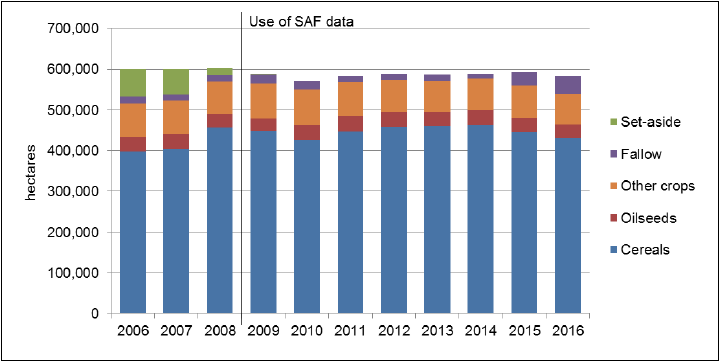
3.3 Cereals
In June 2016, the total area of cereal crops was 432,000 hectares, down 12,400 hectares (2.8 per cent).
As usual, spring barley was the dominant cereal crop accounting for 239,000 hectares (55 per cent) of the total cereal area in June 2016, with winter barley adding a further 48,000 hectares (11 per cent of the total cereal crop area). Wheat accounted for 110,000 hectares (25 per cent of the total cereal crop area). Spring oats predominated over the winter variety with 23,000 hectares (5.4 per cent of the total cereal crop area), compared with 8,100 hectares (1.9 per cent of the total) of winter oats.
There were 3,700 hectares of rye in Scotland in 2016, a nine-fold increase from the 400 hectares recorded in 2014. This is the first time this crop (which can be used in anaerobic digestion plants) has featured in this publication, though the area is comprised only of data from holdings submitting a SAF. Holdings from SAF data constitute 90% of the agricultural land area in Scotland.
In 2015, change were made to the EU Common Agricultural Policy (CAP) support schemes. This included changes to the criteria for accessing the Basic Payment Scheme (BPS) - previously called Single Farm Payments (SFP). In particular, there was a requirement for crop diversification. Though this is the second set of results since these have been introduced, it may be that changes in land use this year reflect continuing efforts being made to adhere to the requirements. In particular, the decline in cereals was accompanied by a rise in the areas of fallow land and oats, however the fall in the area of barley may also be partly linked to low prices and wet weather during the spring planting season.
Chart 4: Cereal trends, 2006 to 2016
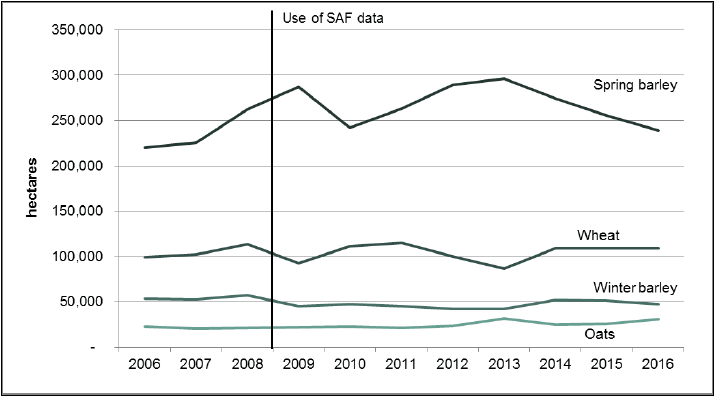
Compared to 2015, the area of spring barley decreased by 17,000 hectares (6.6 per cent) to 239,000 hectares. Winter barley decreased by 3,800 hectares (7.3 per cent). The area of wheat was largely unchanged, increasing by only 31 hectares. Spring oats increased by 5,100 hectares (28 per cent). Winter oats increased by 500 hectares (6.7 per cent) to 8,100 hectares, the highest figure since this crop was recorded separately (1995).
The trends between June 2015 and June 2016 demonstrate:
- A decrease in spring barley of 17,000 hectares (6.6 per cent) to 239,000 hectares.
- A decrease in the total area of barley of 21,000 hectares (6.7 per cent) to 287,000
- The area of wheat has remained at around 110,000 hectares.
- An increase in oats of 5,600 hectares (21.8 per cent) to 31,000 hectares.
More information
Statistics on crop yield and production for cereals and oilseed rape are available from Scottish Harvest Publications [3] . First estimates of the 2016 cereal and oilseed rape harvests were published on 6th October 2016.
3.4 Oilseed rape
Over the past ten years, the total area of oilseed rape has fluctuated between 29,000 and 39,000 hectares. Figures for June 2016 show a fall of 5,200 hectares on the previous year to 31,000 hectares. Winter oilseed rape decreased by 5,100 hectares (14 per cent), while the combined area of spring oilseed rape and linseed [4] (which has settled below 1000 hectares since 2014) fell back by 160 hectares to 590 hectares, the lowest figure recorded since collection started in 1988.
Chart 5: Oilseed rape (OSR) trends, 2006 to 2016
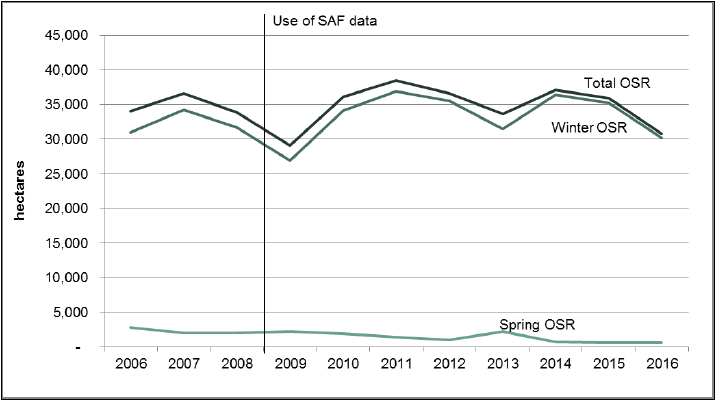
3.5 Potatoes
The area of potatoes sown rose for the first time since 2009, when SAF data began being used, with high prices evident. The area of both ware and seed potatoes rose, with the former increasing by 1,100 hectares (8.2 per cent) and the latter by 650 hectares (5.3 per cent).
Chart 6: Potato trends, 2006 to 2016
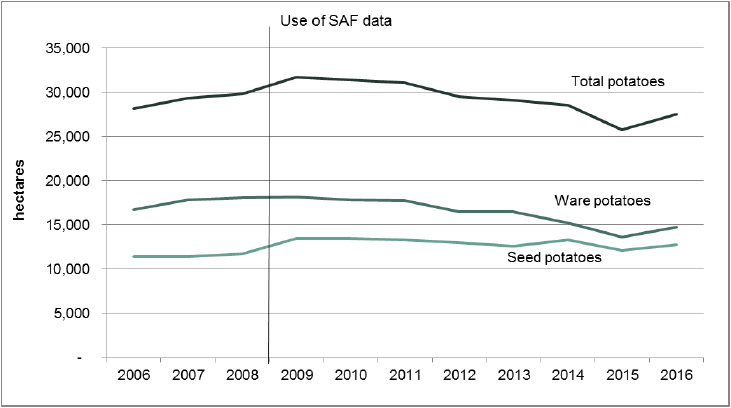
Maps 1 and 2 show the percentage of the total area in a parish (not just of the area of agricultural holdings) that was used for growing cereals and potatoes. Where there are too few producers in an area the data are deemed disclosive and so are grouped with a neighbouring area or areas. The overall pattern is not considered to be greatly affected by this suppression.
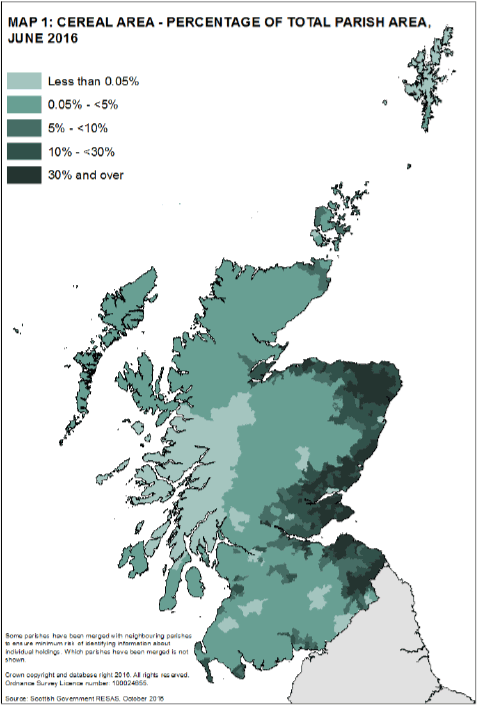
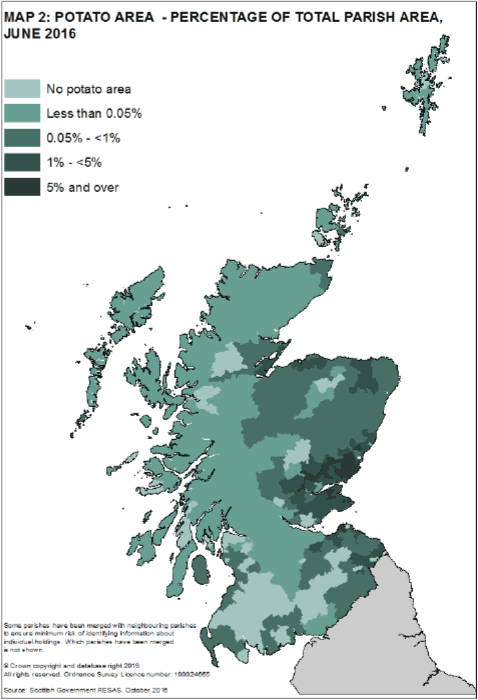
3.6 Peas & beans for combining
The peas and beans described here are usually harvested by combine harvester (hence the name) and used as a source of protein in animal feed. Chart 7 demonstrates that there has been considerable fluctuation in the area of beans. The 2016 figure, for example, fell by 1,000 hectares (26 per cent) following a rise of similar magnitude the previous year. Similarly, the area of peas for combining fell by 700 hectares (47 per cent) after more than doubling in 2015.
Chart 7: Trends in peas & beans for combining, 2006 to 2016
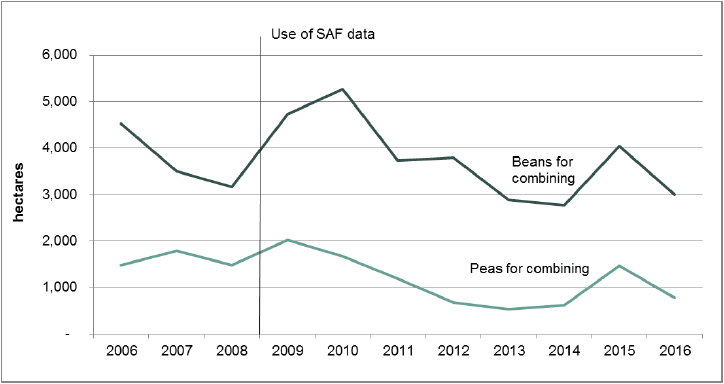
3.7 Crops for stockfeeding
The total area of stockfeeding crops declined markedly between 2006 and 2008, which coincided with a greater rate of decline in cattle and sheep numbers. The area remained fairly s between 2008 and 2010 but declined in 2011 by 3,000 hectares (13 per cent), possibly due to farmers responding to higher prices in cereals and switching crops. In June 2016 the area fell by 1,400 hectares (7.8 per cent) to 16,500. Change amongst the individual crops in this group was modest, with the exception of maize (where the area was almost halved to 760 hectares), rape (down 16 per cent to 2,000 hectares) and other stockfeeding crops (down five per cent to 7,100 hectares).
Chart 8: Trends in stockfeeding crops, 2006 to 2016
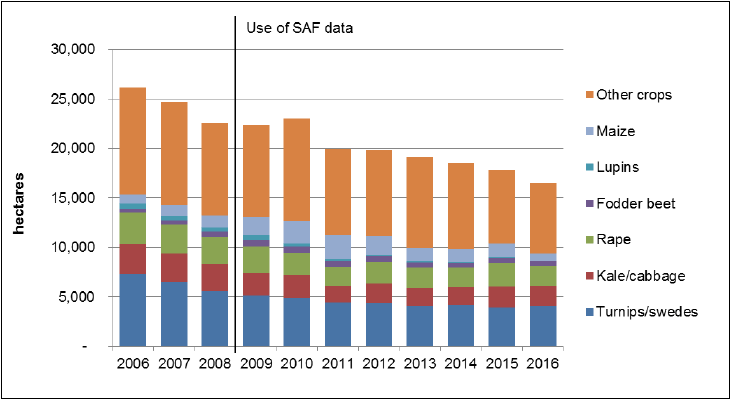
3.8 Vegetables for human consumption
Chart 9: Vegetables for human consumption, June 2016
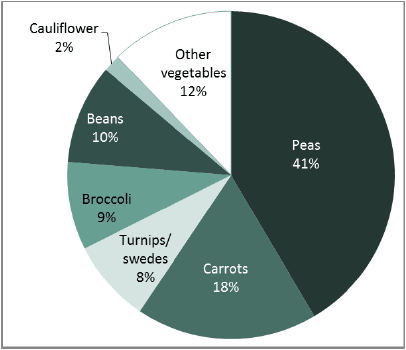
The total area of vegetables grown in the open for human consumption at June 2016 increased by 1,500 hectares (nine per cent) to 18,200 hectares, the largest rise (both in terms of percentage and area) since SAF applications began to be used as the primary source of land data in 2009. As has been the case over the last ten years, peas were the dominant vegetable accounting for 42 per cent of the total vegetable area, followed by carrots (18 per cent), beans (ten per cent), broccoli (calabrese) (nine per cent), turnips/swedes (eight per cent), with all other vegetable crops contributing 12 per cent.
Trends show that the total vegetable area increased by 1,700 hectares (16 per cent) between 2003 and 2008, mostly due to increases in peas and carrots.
The increase in vegetables from 2015 to 2016 was driven by increases in all crops, though peas (up 510 hectares or seven per cent), carrots (up 380 hectares or 13 per cent) and beans (up 320 hectares or 22 per cent) accounted for the largest increases.
The area of vegetables planted, which is often related to demand and contracts with supermarkets, has almost doubled since 1988. The increase in the area of vegetables of 3,700 hectares (31 per cent) between 2008 and 2009 however, probably represents a jump in the data series following the switch to using SAF data for those holdings claiming Single Farm Payment.
Chart 10: Vegetables for human consumption, trends 2006 to 2016
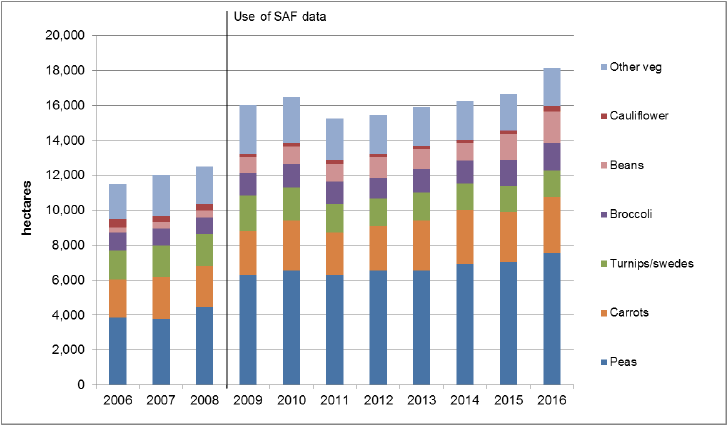
3.9 Fruit
In 2012, the SAF was amended to collect more detailed information on soft fruit, particularly with regard to identifying whether crops were grown in open fields, glasshouses or walk-in plastic structures. This resulted in a large shift from those areas reported as open field towards those classed as grown under walk-in plastic structures or glasshouses.
Chart 11 presents combined areas of soft fruit in both open field, in walk-in plastic structures and glasshouses. Given the developments in data collection described above, the changes seen in 2009 and 2012 should be treated with some caution.
Between 2015 and 2016 the area of strawberries grown rose by 54 hectares to 990 hectares (a 5.7 per cent increase), largely driven by an increase in crops grown under cover.
Raspberries which, in recent years have been affected by reduced demand and disease such as raspberry root rot, resumed the declining trend evident since 2009 (following an increase in 2015), falling by 25 hectares (seven per cent) to 325 hectares. The area of blackcurrants also fell by 12 hectares (four per cent) to 300 hectares.
In contrast, alternative soft fruits such as blueberries and those encompassed within the 'other fruit' category both increased, by 12 hectares (ten per cent) and by 40 hectares (50 per cent) respectively. Orchard fruit fell 11 per cent to 98 hectares.
Chart 11: Soft fruit trends (both open field and plastic or glasshouse crops) 2006 to 2016
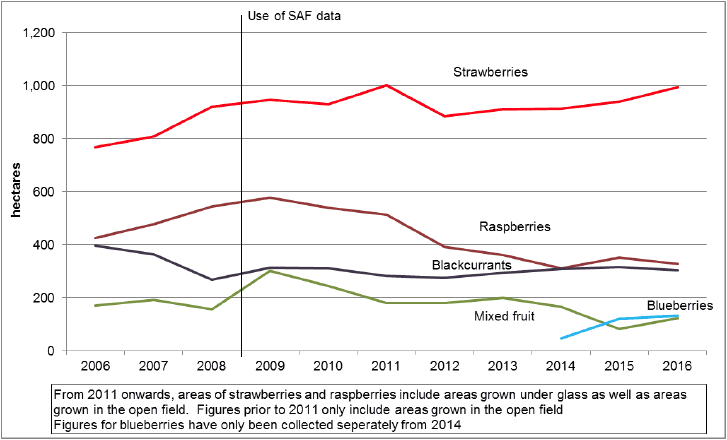
3.10 Bulbs, flowers & hardy nursery stock
In 2015, there was a drop of 330 hectares (26 per cent) in the area of land used to grow bulbs, flowers and nursery stock. This fall was driven by a drop in the recorded area of ornamental trees, which may have been due to changes in the categories used on the 2015 SAF rather than a genuine reduction of ornamental trees or hardy nursery stock. The crop area was, however, maintained in 2016, with only a slight reduction (of just under five hectares or 0.5 per cent) evident in the area of bulbs, flowers and hardy nursery stock.
3.11 Livestock trends summary
Chart 12 presents livestock trends as indices. This demonstrates the relative change of each livestock category from a baseline year of 2006 and can be used to compare trends across livestock types with quite different population totals. Decreases in livestock are evident for all categories across the ten year period, except for poultry. The largest decrease occurred among pigs (29 per cent). Smaller decreases are evident among sheep (11 per cent) and cattle (10 per cent), while poultry rose slightly (by four per cent).
Chart 12: Livestock indices, ten-year trends relative to 2006
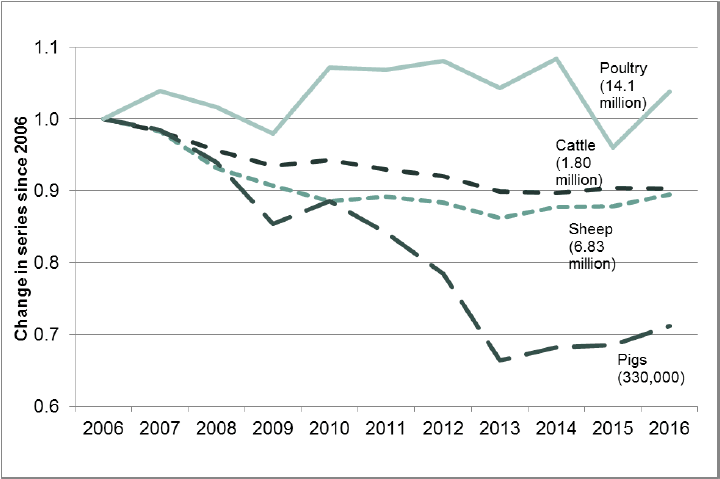
Cattle Tracing Scheme (CTS) data are derived from an administrative data source which records cattle movements across Great Britain and which replaced the collection of cattle data via the census in 2013. CTS data from 2006 onwards have been used in this publication.
In 2005 the Single Farm Payment (SFP) scheme was introduced, which decoupled subsidy payments from most sheep and cattle production, with the exception of the Scottish Beef Calf Scheme. With the introduction of SFP, the decline in sheep numbers accelerated, with a decrease of 11 per cent between 2006 and 2010, although the population has stabilised in the last few years, including increases in 2011 (0.7 per cent), 2014 (1.9 per cent), 2015 (0.1 per cent) and 2016 (1.9 per cent). Cattle numbers have also been in decline, down by 9.7 per cent between 2006 and 2015, though with a small increase in 2015.
Notwithstanding a rise in 2010, pig numbers fell steadily between 2005 and 2013. The rise in pig numbers in 2010 (owing to strong pig prices and an increase in the breeding herd), interrupted falls of 16 per cent between 2005 and 2009, and of 25 per cent between 2010 and 2013. However, since 2013, pig numbers appear to have recovered somewhat, increasing seven per cent.
Between 2005 and 2014, poultry numbers have generally been around 14 million. There is some variability in the annual poultry data, which can be affected by operational factors such as poultry sheds temporarily being empty, for a period including census day, to allow for cleaning. Following restructuring within the industry in recent years, there was an 11 per cent fall in 2015, but this has been followed by an eight per cent rise (1.06 million) this year.
Historically, cattle numbers peaked in 1974 and have been declining since, with levels now back to those seen in the late 1950s. Sheep numbers saw peaks in the 1930s, 1960s and 1990s, but, despite rises in each of the last three years, are currently at levels last seen in the 1940s. Pig numbers saw a very large increase in the 1950s, but about two-thirds of this increase has now been lost. Poultry numbers saw a large increase in the 1970s and have generally fluctuated between 13 million and 15 million since then.
3.12 Cattle
Chart 13: Cattle population, June 2016
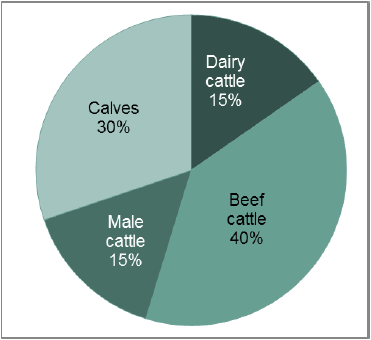
In June 2016, the cattle population was 1.80 million. Looking at those female cattle aged one year and over, the number of beef cattle was 711,000, or 40 per cent of the total; more than two and a half times greater than the number of dairy cattle (276,000, or 15 per cent). In both of these categories, the majority of cattle were those over two years old with offspring.
Male cattle aged one year and over made up 15 per cent of the total, while 30 per cent were calves under one year old. The distribution of cattle amongst the categories displayed in Chart 13 is similar to June 2015.
Overall trends in cattle were described in Section 3.11, with the total number falling 195,000 (9.7 per cent) from 2.00 million in 2006 to 1.80 million in 2016. Chart 14 displays the relative trends of cows in the dairy and beef herds since 2006, the first year in which CTS data were available.
Chart 14: Dairy & beef herd trends, 2006 to 2016
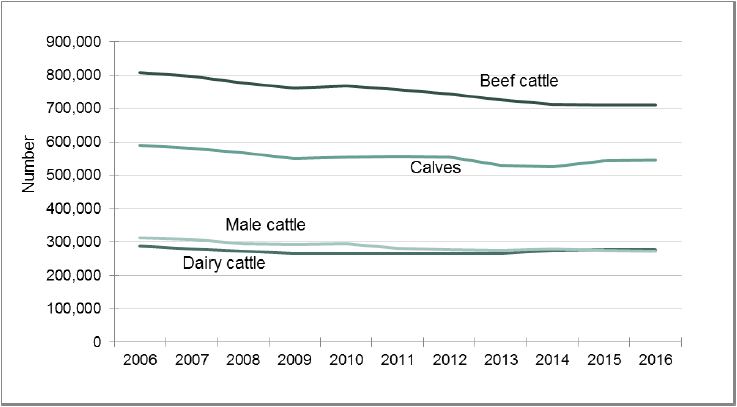
Total cattle numbers decreased, slightly, by 1,800 or 0.1 per cent over the year to June 2016. This however, represents a modest drop in figures following the drop of 4.8 per cent over the four year period from 2010 to 2014. Much of the drop since 2006 can be attributed to higher costs reducing margins, offsetting the benefits of increased prices. However, it must also be noted that this forms part of a downward trend evident since the 1970s.
Differing trends between dairy and beef cattle are seen over the period. There has been a generally upwards trend in the numbers of dairy cattle since a low of 265,000 in 2011, the slight drop in 2016 accompanied low milk prices in the year leading up to June. Nevertheless, the figure of 276,000 was the fourth highest figure in the last ten years. Beef cattle, meanwhile, rose this year for the first time since 2010 (the only other rise in the past ten years).
While there has been minimal change among the main cattle categories between 2015 and 2016, one trend evident this year is a shift from older towards younger cattle. For example, while the number of dairy cattle fell only slightly (by 1,600 or 0.6 per cent), the sizeable drop in the number of dairy cattle aged two and over without offspring (by 4,800 or 10.3 per cent) was largely offset by an increase in the number of one year-old dairy cattle (up 3,800 or 6.8 per cent). A similar trend was evident within the beef cattle numbers.
Again, among male cattle, the decrease of 2,500 (0.9 per cent), mostly driven by a drop in the number aged two years and over, was set against an increase in one year-olds. The number of calves remained fairly steady (up 840 or 0.2 per cent).
Limousin remained the most popular breed in Scotland, followed by Aberdeen Angus and Simmental. Among dairy breeds, Holstein Friesian accounted for over 60 per cent of dairy cattle. Eighty-four per cent of beef cattle were cross-bred, whereas 89 per cent of dairy cattle were pure-bred.
Chart 15: Cattle breeds, by use and whether pure-bred, June 2016
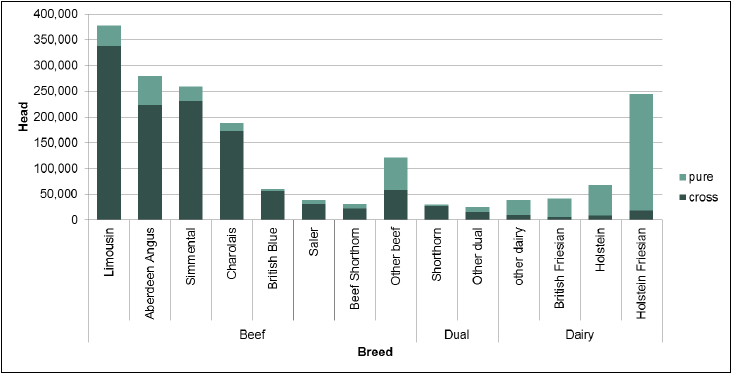
Map 3 shows the number of cattle per hectare, using the total area in the parish, not just the area of agricultural land. Where there are too few producers in an area the data are deemed disclosive and so are grouped with a neighbouring area or areas. The overall pattern is not considered to be too adversely affected by this suppression.
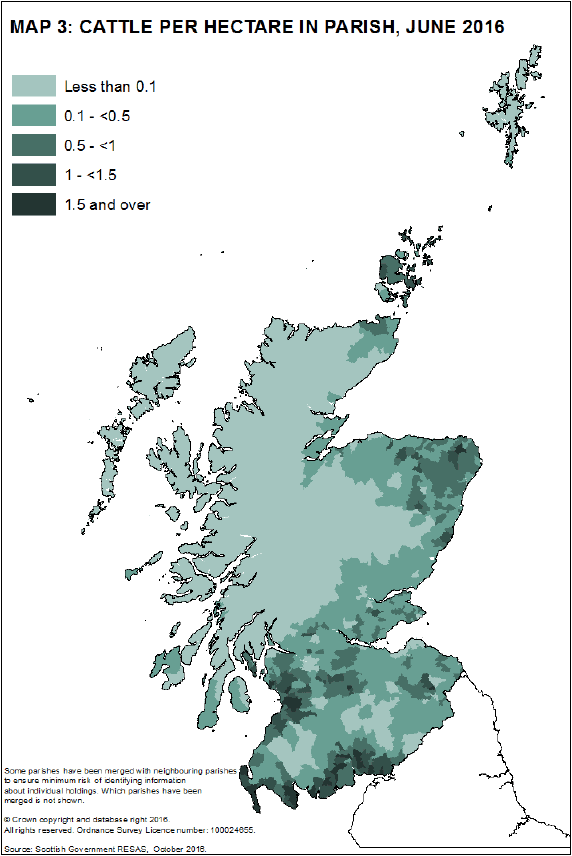
The latest annual trends between 2015 and 2016 show:
- A decrease in total cattle of 1,800 (0.1 per cent) to 1.80 million.
- A decrease in the number of dairy cattle of 1,600 (0.6 per cent) to 276,000.
- An increase in the number of beef cattle of 1,500 (0.2 per cent ) to 711,000.
- A decrease in the number of dairy cows of 540 (0.3 per cent) to 175,000.
- The number of beef cows remained at 437,000.
- An increase in the number of calves of 840 (0.2 per cent ) to 545,000.
3.13 Sheep
Chart 16: Sheep population, June 2016
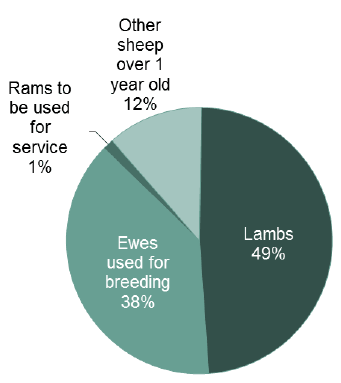
In June 2016 the sheep population was 6.83 million, a 1.9 per cent increase on 2015. Ewes used for breeding in the previous season accounted for 38 per cent of the total, with rams to be used for service just over one per cent. Lambs made up the largest proportion with 49 per cent and other sheep over one year old accounted for 12 per cent. Lamb numbers increased by 90,000 (2.8 per cent) compared with last year.
Overall trends in the sheep population were described in section 3.11, with the total decreasing by 800,000 (10.5 per cent) from 7.63 million in 2006 to 6.83 million in 2016.
Chart 17 displays trends for breeding ewes and lambs, which in June 2016 made up 87 per cent of the total sheep population. Over the past ten years there has been a decline of 410,000 among ewes for breeding (14 per cent) from 3.03 million in 2006 to 2.62 million in 2016. However, most of this decline occurred between 2006 and 2010, with more modest falls since then. Lamb numbers have declined alongside ewe numbers for much of the past decade, falling by 590,000 (16 per cent) from 3.69 million in 2006 to 3.11 million in 2013. Since then, however, numbers have recovered somewhat, with rises in two of the past three years.
Chart 17: Ewes for breeding and lambs, trends 2006 to 2016
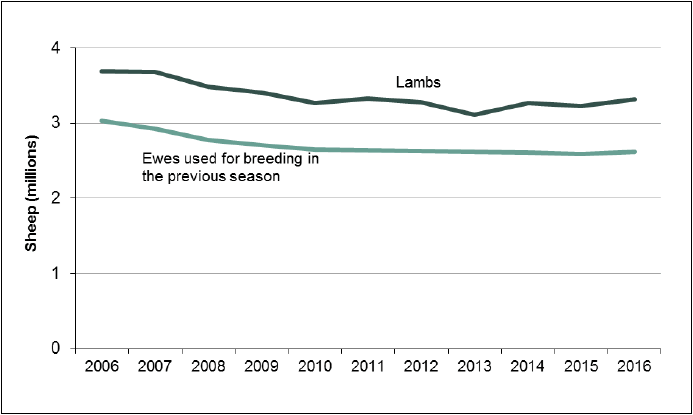
The introduction of Single Farm Payments in 2005 signalled a steeper decline in sheep numbers than had been witnessed earlier in the decade (following restocking after the 2001 foot and mouth outbreak) with a decrease of 1.13 million sheep evident between 2005 and 2010 (annual average decline of 3.0 per cent).
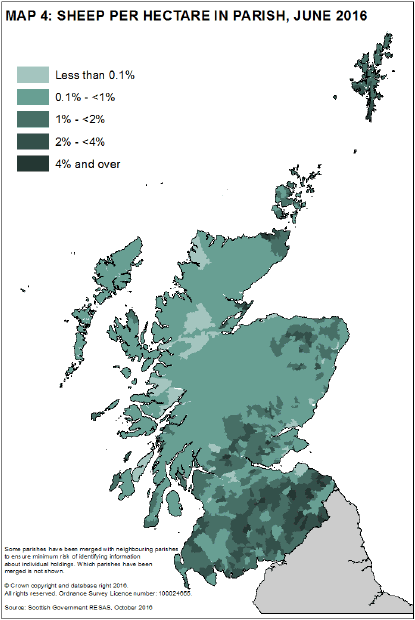
Since 2010 the number of sheep has generally been around 6.7 million, with fluctuations driven by variability in the number of lambs. The annual lamb numbers have been affected by how harsh the winters and springs have been.
Map 4 shows the number of sheep per hectare, using the total area in the parish, not just the area of agricultural land. Where there are too few producers in an area the data are deemed disclosive and so are grouped with a neighbouring area or areas. The overall pattern is not considered to be too adversely affected by this suppression.
The latest annual trends between 2015 and 2016 show:
- An increase in total sheep of 125,000 (1.9 per cent) to 6.83 million.
- An increase in ewes used for breeding of 30,000 (1.2 per cent) to 2.62 million.
- An increase in lambs of 90,000 (2.8 per cent) to 3.32 million.
- An increase in other sheep aged one year and over of 1,800 (0.2 per cent) to 798,000.
3.14 Pigs
Chart 18: Pig population, June 2016
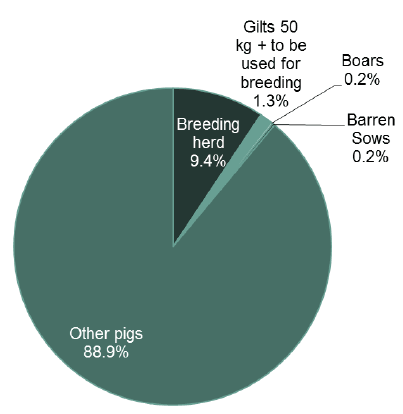
In June 2016 the pig population was 330,000. The breeding herd accounted for 9.4 per cent of the total, with a further 1.3 per cent being gilts (over 50 kg) to be used for future breeding. Boars and barren sows made up only 0.2 per cent of the population each while the vast majority (89 per cent) were other pigs most of which would be used for meat production.
Chart 19 shows the relative trends over the past ten years of the breeding herd and of other pigs (mostly used for meat production). Note that each data series has a different axis, with breeding herd numbers shown on the left axis and other pig numbers on the right axis.
Overall trends in the pig population were briefly described in Section 3.11, with the total decreasing from 464,000 in 2006 to 330,000 in 2016 (a drop of 29 per cent). Over the same period, the breeding herd decreased by 10,800 (26 per cent) to 31,000 whilst other pigs for fattening decreased by 120,000 (29 per cent) to 294,000.
Pig numbers have been declining steadily since a peak in the late 1990s. They dropped below 300,000 in December 2013 [5] following the closure of the Hall's meat processing factory in late 2012. However pig numbers have risen every year since 2014. Over the last twelve months total pig numbers rose by 12,500 (four per cent) to 330,000, mainly driven by fattening pigs, which rose by 15,000 (5.4 per cent) to 294,000.
Chart 19: Breeding and other pigs, trends 2006 to 2016
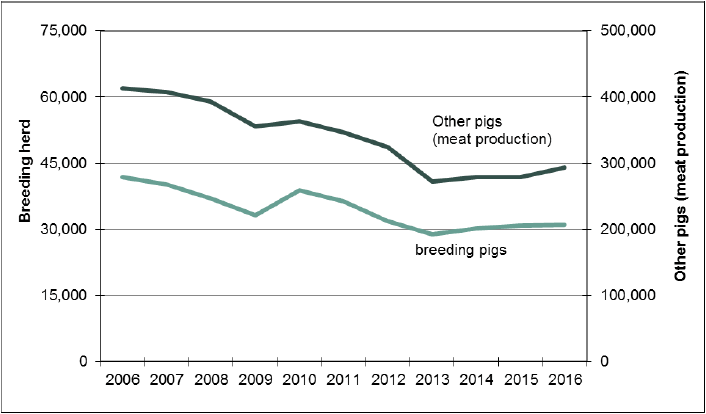
The latest annual trends between 2015 and 2016 show:
- An increase in total pigs of 12,500 (3.9 per cent) to 330,000.
- An increase in the breeding herd of 124 (0.4 per cent) to 31,000.
- An increase in other pigs (mostly for meat production) of 15,000 (5.4 per cent) to 294,000
3.15 Poultry
Chart 20: Poultry population, June 2016
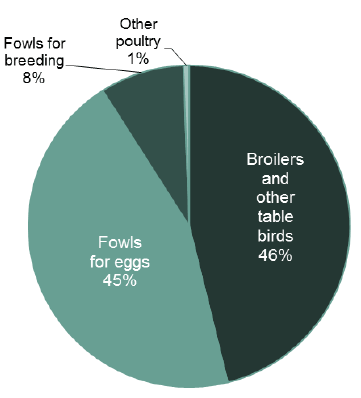
In June 2016 the total poultry population was 14.11 million. In recent years, the number of broilers has declined, and now only account for 46 per cent of the poultry flock. Almost as many (45 per cent) are hens and pullets in, or being reared for, the laying flock. Fowls for breeding accounted for 8 per cent. Other poultry (including turkeys) made up just under one per cent of the total.
Overall trends in the poultry population were described in Section 3.11, with the total fluctuating around 14 million, though restructuring within the industry in 2015 so saw the figure dip temporarily to just over 13 million.
Chart 21 shows differing trends over the past ten years for poultry used for meat and egg production. There has been an increase in the number of fowls for producing eggs (up 2.7 million or 76 per cent) between 2006 and 2016. There has been a decrease in broilers and other birds of 2.05 million (24 per cent) over the last ten years, with particularly large falls since 2012. The breeding flock also fell, by 176,000 (13 per cent) to 1.19 million.
Chart 21: Trends in broiler & birds, and fowls for producing eggs, 2006 to 2016
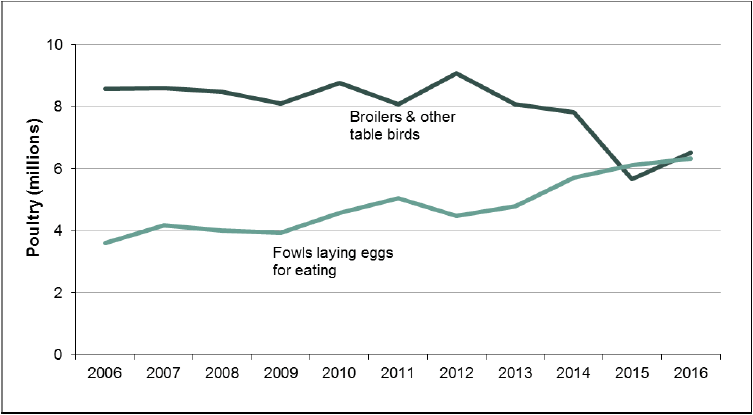
The EU Directive 1999/74/EC, which placed minimum requirements on the size and conditions of cage systems was introduced in 2012 and was accompanied by a fall in the number of fowls producing eggs in that year's census. However, the number of fowls producing eggs has risen by 1.86 million in the four years since, linked also to a switch from broiler production. The number of fowls producing eggs in June 2016 was the highest figure over the ten year period.
The latest annual trends between 2015 and 2016 show:
- An increase in total poultry of 1.06 million (eight per cent) to 14.11 million
- An increase in fowls laying eggs for eating of 216,000 (3.5 per cent) to 6.33 million.
- An increase in broiler and other birds of 840,000 (15 per cent) to 6.51 million.
3.16 Other Livestock
The number of "horses not for agricultural use" has increased over the past ten years by 4,000 (13 per cent) to 34,000. There were only a small number of horses used for agriculture, totalling 1,300 in 2016, though these have risen in number for seven consecutive years. There were an estimated 1,450 donkeys in June 2016. Note that data on donkeys were collected separately for the first time in 2015 and, prior to this, some donkeys were included in the non-agricultural horse numbers.
Since 2006, the number of farmed deer has varied between a high of 7,200 (in 2015) and a low of 5,900 (in 2009). Between 2015 and 2016 the number of deer fell by 230 (3.2 per cent) to 7,000.
Information on bee hives has been collected since 2014, and returns showed that there were an estimated 4,900 beehives on agricultural holdings in June 2016. This includes hives that were present on agricultural holdings on census day, whether owned or brought in.
There were an estimated 1,800 camelids on holdings in June 2016, almost unchanged from the previous year. Not every holding completes a census form each year, and so it can take several years to achieve complete coverage for new livestock categories. The estimates for camelids, beehives and donkeys include a scaling up of the recorded figures to take into account holdings that have yet to be included in the census sample. These estimates will become more accurate once data have been collected for several years. See notes section 4.5 for more details of methodology.
Note that in chart 22, the data for non-agricultural horses are relative to the right-hand axis, with all other livestock on the left-hand axis.
Chart 22: Other livestock trends, 2006 to 2016
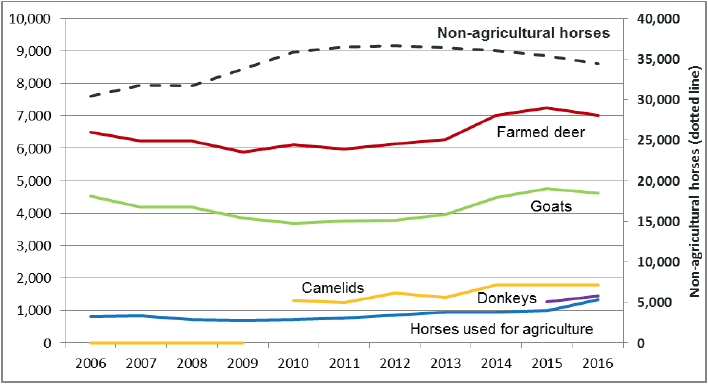
3.17 Agricultural Labour
Chart 23: Agricultural labour, June 2016
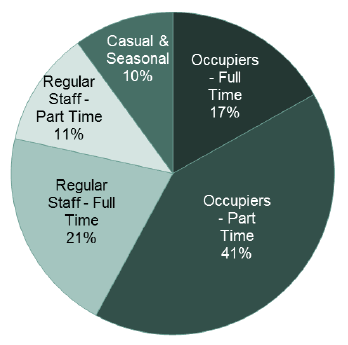
On the 1st June 2016, there were 63,400 people (headcount) working on agricultural holdings. Working occupiers [6] made up 58 per cent of the total workers (split between 17 per cent full-time and 41 per cent part-time). Regular staff accounted for 32 per cent of total workers (of which more were working full-time than part-time). A further breakdown of the various categories included within regular staff can be found in Chart 29. Casual and seasonal workers represented ten per cent of the total.
This year, 64 per cent of working occupiers were male. Working male occupiers were more likely to be older, with 36 per cent of male occupiers aged under 55 compared with 41 per cent of female occupiers. It is also evident that the gender profile of occupiers differs between full time (83 per cent male) and part time occupiers (53 per cent male). This data is based solely on actual returns for holdings which returned information on occupier age and gender in 2016.
Chart 24: Age and gender profile of occupiers, June 2016
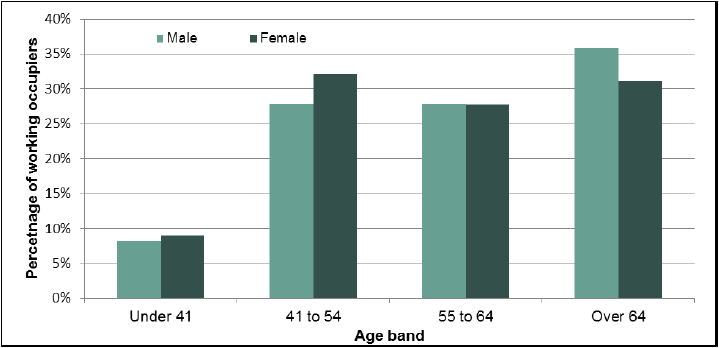
Between 2015 and 2016, the number of people working in agriculture decreased by 1,900 (three per cent). This follows similar drops in 2013, 2014 and 2015. The fall in numbers was largely driven by a drop in the number of working occupiers which fell by 1,200 (3.3 per cent). There was also a no decrease in the number of casual and seasonal workers, which dropped by 490 (seven per cent) to 6,350, the lowest figure since 2010.
It should be noted that some of the annual changes in labour in the past may have been affected by changes in the census form. Inclusion of EC Farm Structure Survey (FSS) questions on the June 2010 census (and the associated redesign of the survey form) led to some labour sections either not being reported correctly or being missed out by survey respondents. In 2011 the census form reverted back to its usual design and, it appears, has resulted in a spike or drop for some labour categories in 2010, particularly evident in the numbers for occupiers and male regular staff.
Looking at longer-term trends, the number of people working on agricultural holdings has fluctuated over the last ten years from a high of 68,400 in 2012 to a low of 63,400 in 2016, the figure for 2016 being the lowest figure since our current records began in 1982. These totals need to be treated with some caution as they include differing trends for full-time and part-time occupiers, and regular employees. Full-time equivalent figures, were they available, might give a different picture. In addition, the drop in numbers of occupiers may be partly due to the fact that, following the addition of the question about non-working occupiers in 2011 [7] , not all holdings would have been included in the census samples in the years afterwards and so had the opportunity to respond. This has potentially resulted in an over-count of the number of working individuals and an undercount in the number of non-working individuals, in the years that followed, though the effect of this decreases each year.
Chart 25 shows that trends for occupiers and regular employees reflect some similarity with the total workforce figures, portraying a gentle decline over the ten year period, with a slightly steeper drop and recovery in the years 2006 to 2010. Compared with 2006, the total number of working occupiers is now 5,400 lower (13 per cent), whilst the number of regular employees is virtually unchanged at 20,400.
In contrast, the number of casual and seasonal workers - largely associated with the soft fruit sector - is up 1,800 or 40 per cent since 2006. Figures on migrant workers, published for the first time this year, show that 430,000 person working days were undertaken in the year to June 2016, down 6.5 per cent on the previous year. On the basis that one full time employee works the equivalent of 1,900 hours per year, this figure equates to around 1,800 people working full time (note however that this is a notional figure rather than a headcount).
Chart 25 :Agricultural labour trends, 2006 to 2016
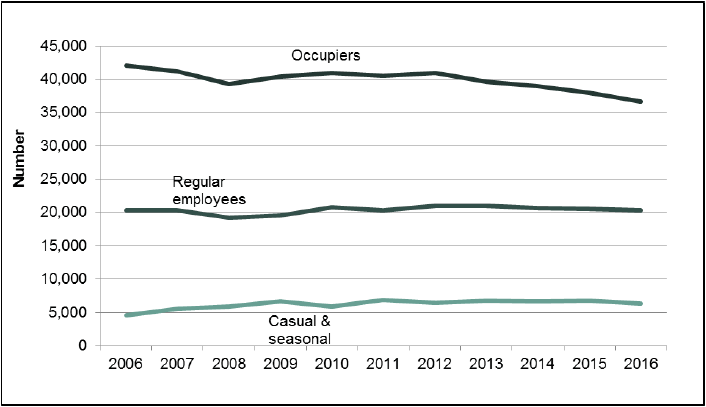
Chart 26 below provides a further breakdown of trends in working occupiers. It shows that, from 2006, numbers of full-time occupiers declined from 12,600 to 11,300 in 2008, with numbers falling only slightly (by 640 or six per cent) since then. The number of occupiers working part-time but "half-time or more" has been close to around 6,000 since 2006, whereas the number of occupiers working "less than half-time" has been more variable, with a rise of 1,300 (six per cent) between 2008 and 2010 followed by a fall of 3,200 (14 per cent) from 2010 to 2016. However, this category may have been particularly affected by the introduction of the non-working occupier question in 2011. It is also worth noting that high figures in 2010 may be an effect of adding the FSS questions and altering the design of the form for that year.
Chart 26 :Occupiers, trends, 2006 to 2016
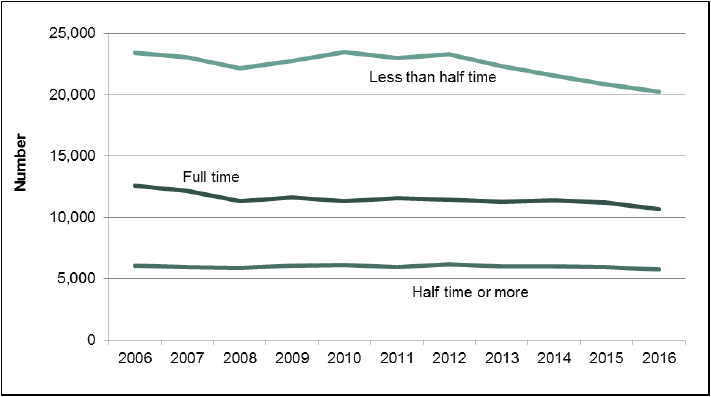
Charts 27 and 28 provide a further breakdown of trends in regular employed staff. They show that the overall trends are almost entirely driven by trends in full time male staff. The numbers of full-time male staff decreased by 830 (6.8 per cent) between 2006 and 2008. Other than 2010, numbers have remained around 11,500. The trend in full-time female staff, meanwhile, was generally upward, with a rise of 360 (25 per cent) over the 10 year period. In both cases, a spike in 2010 is particularly noticeable, but the possible effect of the merger of the 2010 FSS with the Census that year should be borne in mind.
Chart 27: Regular male staff, trends 2006 to 2016
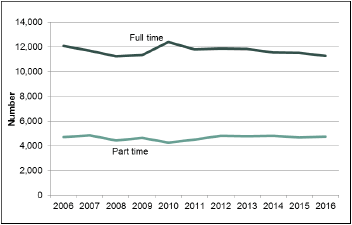
Chart 28: Regular female staff, trends 2006 to 2016
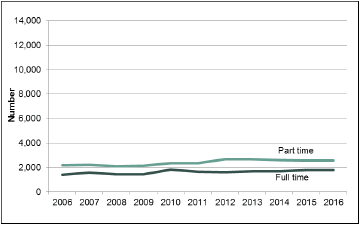
Chart 29: Regular staff, June 2016
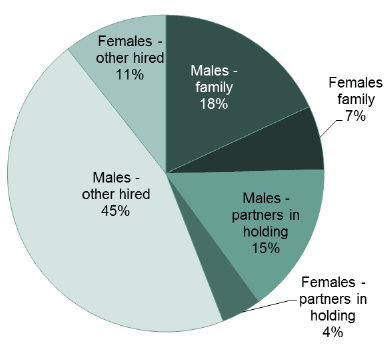
Chart 29 shows, in greater detail, the relative proportions of regular staff noted in Charts 26 and 27. On the 1st June 2016, there were 20,400 regular staff working on agricultural holdings, down 0.9 per cent from the previous year.
One quarter were members of occupiers' families and a further 19 per cent were business partners in the holding. The remaining staff were hired staff (56 per cent), the majority of whom were males. These proportions are similar to those in 2015.
3.18 Rented land
Information on agricultural crofts and tenancy arrangements is collected in the June agricultural census for those holdings that rent land.
In 2016 there were 1.32 million hectares of land rented (including crofts and excluding seasonal lets), similar to the area in 2015. In 2016 rented land accounted for 23 per cent of agricultural land, compared with 29 per cent of agricultural land in 2006. While the area of land under secure tenancy till dropped (down 53,000 hectares), this was countered by a rise of the same magnitude in the area associated with fixed term tenancies. Note that areas of land rented under various tenancy agreements are estimated based on data received from holdings. Information on how these figures have been calculated here is available in section 4.12.
Chart 30: Proportion of total area under a full tenancy or rented croft, 2006 to 2016
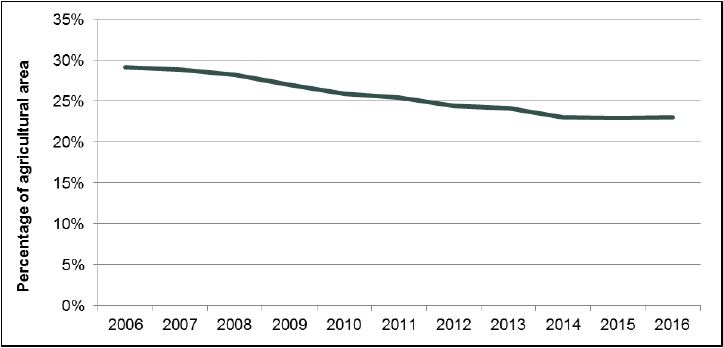
Map 5 shows the geographic distribution of tenanted land (excluding crofts). Tenanted land was more prevalent south of the central belt, in Angus and Moray and around the mouth of the Clyde.
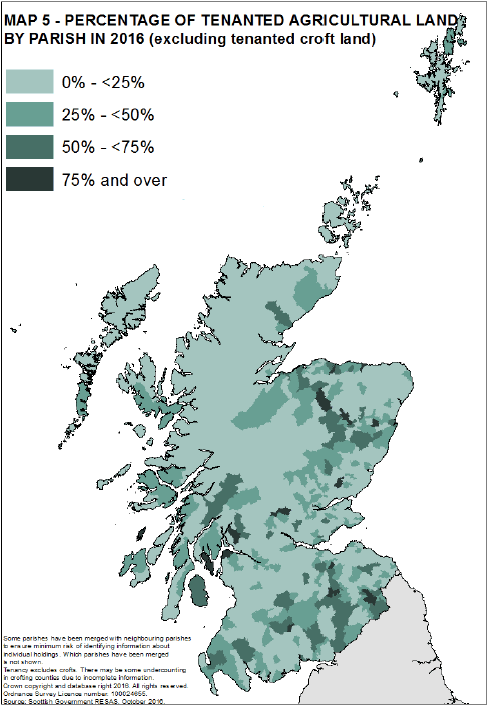
3.19 Holdings renting land for one year or more
In 2016 there were 16,500 holdings with rented land. Of these holdings, 10,000 were on the Crofting Commission Register or had recorded they were renting a croft. The other 6,500 holdings had other types of rental arrangement (91 Act tenancy, 91 Act Ltd Partnership, SDLT, LDT, or SLA) only. However, some crofts may also rent land under these other arrangements. Of the 7,800 holdings with crofts that provided data, 70 (0.9 per cent) had other tenancy arrangements in addition to their crofting tenancy. If this proportion is applied to the 2,200 holdings with crofts that have not provided tenancy type data, that would imply that a total of 89 holdings with crofts also have other tenancy arrangements. Summing the 6,500 holdings with non-croft tenancies to these 89 holdings provides us with a figure of 6,600 holdings with non-croft tenancy arrangements.
10 and chart 31 provide these figures from 2008 to 2016. The estimated number of holdings with a (non-croft) tenancy agreement has fallen by 22 (0.3 per cent) since last year, and fallen 1,460 (18 per cent) since 2008.
Chart 31: Number of holdings with a (non-croft) tenancy arrangement, 2008 to 2016
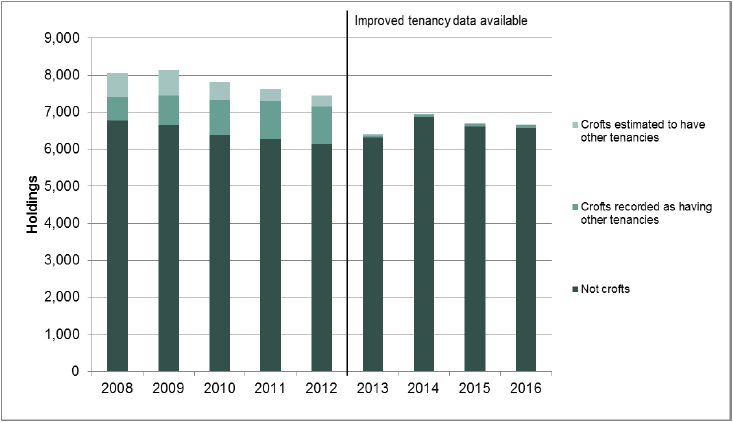
There are six different types of rental arrangements recorded on the June Agricultural Census. They are:
- Rented croft (found only in crofting counties and areas defined in legislation)
- Small Landholders Act Tenancy (lease of land only where the tenant provides all equipment, including the house)
- 91 Act tenancy: A tenancy for one year or more with full security of tenure and succession rights.
- 91 Act, Ltd Partnership: A tenancy for one year or more where the tenant is in a limited partnership.
- Short Limited Duration Tenancy (SLDT): entered into for between one and five years duration.
- Limited Duration Tenancy (LDT): entered into on or after Martinmas (28th November) 2003 for ten years or more and with a specific end date.
Please note that although census data on the area of rented land is considered sufficiently complete, a considerable amount of data identifying what type of tenancy they are held under is incomplete. Detailed tenancy information has only been collected on the June Agricultural Census since 2008. Due to some smaller holdings not being sent a census each year, and some sampled holdings not returning a census or not completing this section, complete coverage of all agricultural holdings in Scotland is not available.
Prior to June 2014, where a rented holding's tenancy type was unavailable, it was, in some cases, assumed that the tenancy was a 91 Act tenancy, this being by far the most common tenancy type. However, this means that 91 Act tenancies were over-estimated, and all other tenancy types were potentially under-estimated.
Measures have been taken to improve the accuracy of data on tenancy agreements for the years since 2013, and information on how these figures have been calculated here is available in section 4.12. However, whilst this has improved the quality of the figures, they are not directly comparable with previous years. Finally, a number of smaller, non-commercial holdings have been removed from the census dataset this year, reducing the number of holdings with tenancy agreements.
Chart 32a and 32b provide a breakdown of tenancy types from 2008 to 2016. Compared with June 2015, there has been a decrease in the number of holdings with a 91 Act tenancy (down 3.5 per cent) and with a 91 Act partnership (down 2.9 per cent), whilst there have been increases in the number with LDTs (up 16 per cent) and SLDTs (up 13 per cent). The most common tenancy type was 91 Act tenancy, which accounted for 72 per cent of agreements on holdings with non-croft tenancy arrangements, slightly down from the figure in 2015.
Chart 32a: Number of holdings by tenancy type, 2008 to 2016
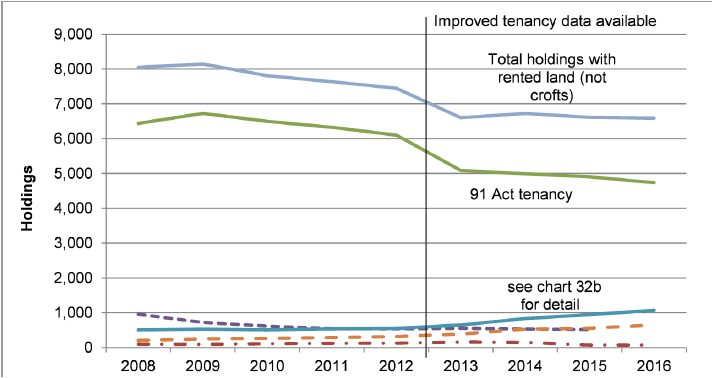
Chart 32b: Croft and non-croft rental arrangements by agreement type, 2008 to 2016
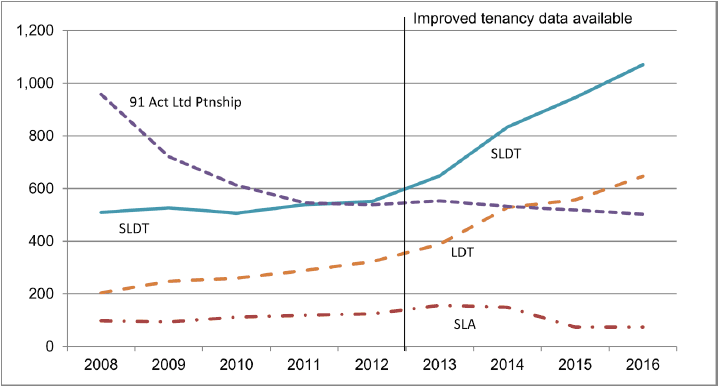
3.20 Holdings renting land on seasonal lets
The current format of the Single Application Form means that we have been unable to provide data on seasonal lets for either 2015 or 2016. Please see the 2014 Census Results [8] for the most recent available data.
3.21 Farm types
Farm types represent a classification of the main agricultural activity taking place on holdings, based on their Standard Output (SO). SOs represent the notional farm-gate worth generated by a holding by applying multipliers (in £s) to its crops and livestock. These are applied uniformly across Scotland. More information on how farm types were calculated in 2016 can be found in section 4.13. The methodology for allocating farms to farm types has changed slightly since last year.
The most common farm type was forage (21,300 holdings), followed by cattle and sheep (LFA) (14,500 holdings) and mixed holdings (5,200). Non-LFA cattle and sheep, cereal (with around 2,500 holdings each) and general cropping farms (1,700 holdings) were fairly prevalent. Horticulture, poultry and dairy farms each numbered between 700 to 900 while pig holdings were the least common farm type (240 holdings).
Map 6 shows the geographic distribution of these farm types. It should be noted, however, that this shows a generalised view by parish rather than by holdings, with a parish being allocated the farm type of whichever category of farm type has the highest total SO total within the parish. The map also splits LFA cattle and sheep into the categories 'beef' and 'other'.
While the map shows what the most common type is in a given area, it should not be taken to illustrate where activities most commonly take place. For example, it may be correct to imply from the map that cereal farming generally takes place in the east but, despite it being the dominant farm type in the Highlands, it would be wrong to infer that cattle and sheep are more prevalent there than elsewhere in Scotland. In fact, cattle and sheep are generally found south of the central belt and in Grampian - cattle and sheep only dominate in the north-west because of the relatively little amount of other farming activity undertaken there.
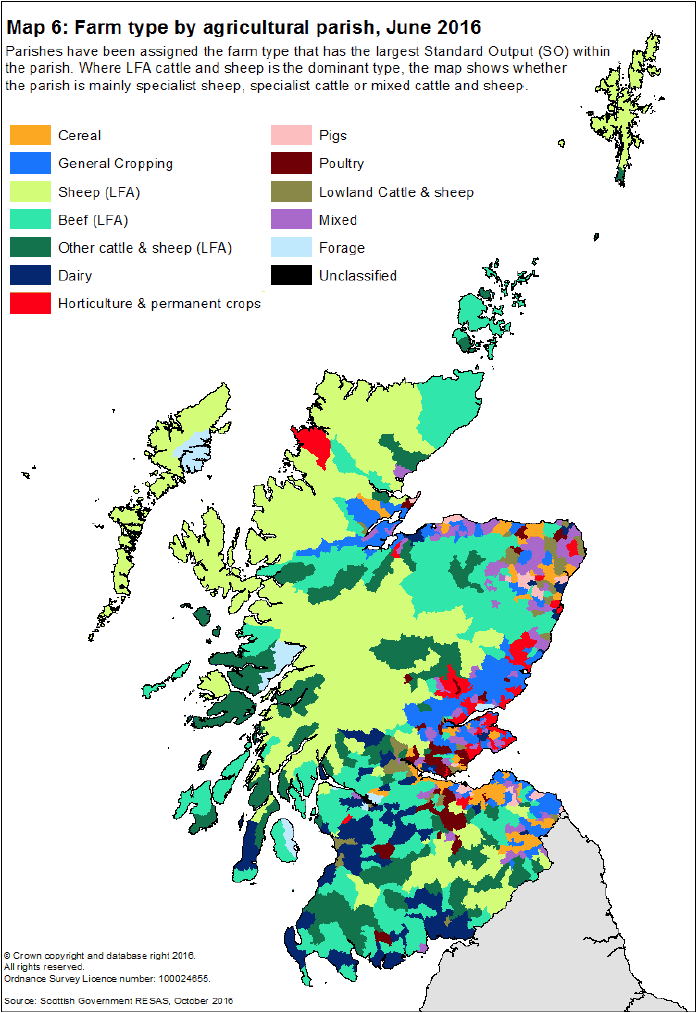
Contact
There is a problem
Thanks for your feedback